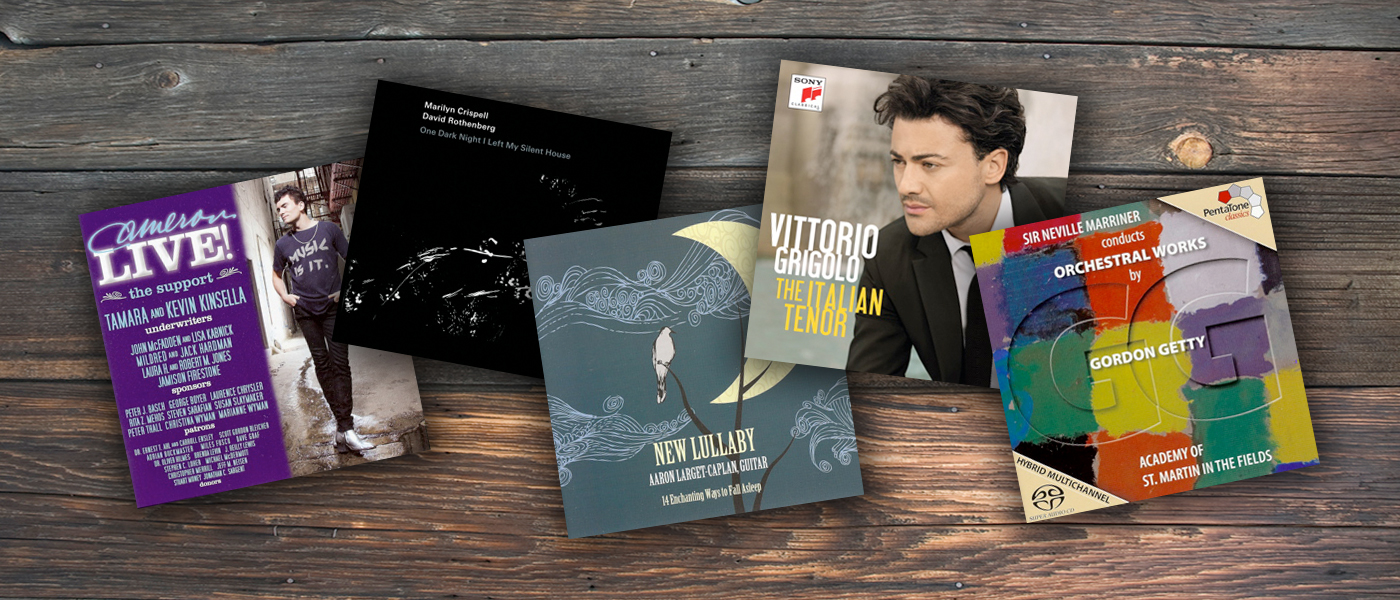Sales of high definition (high resolution or “high rez”) music on discs have floundered, and producers are in a difficult bind because it is expensive to master them, and with profits on high rez albums thus being low, they are looking for a different outlet. Well, downloading high rez music is the answer. The music studios, as well as independent musicians, can simply transfer the original high resolution masters (usually 24/88.2 or 24/96) to websites that specialize in selling music by download. The high rez disc does not have to be created, packaged, or distributed by the studio. It costs them nothing to put the music on a website store. The consumer downloads the music and burns it to a disc or plays it from a computer. The reviews here represent our first set of high resolution albums that were downloaded and burned to DVD-A. Most are 24/88, but one is 24/96, and another is 24/44.1. I burned them all to DVD+R media using a software program (the procedure is described here) and listened to them with an OPPO BDP-83/NuForce universal player, Lamm LL1 preamplifier, McIntosh MC1201 power amplifiers, and Carver Mark IV ribbon speakers.
I obtained all of these albums courtesy of HDtracks on-line. Some albums are remastered from the original recordings made in the 1970’s on analog tape and converted to SACD two-channel and multi-channel surround sound. The audio files at the HDtracks website are two-channel PCM versions.
![]()
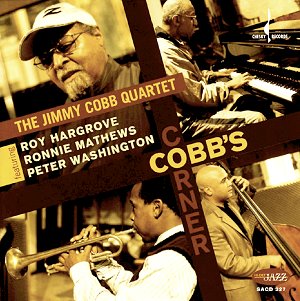
First up is an album called Cobb’s Corner. The name refers to Jimmy Cobb, whose drumming expertise was most famed when he joined Miles Davis’ group back in 1957, but he was well known before that. Nevertheless, he was the drummer on the most successful jazz album ever recorded, Kind of Blue. In those days, it was all LPs. No CD, no DVD-A, no SACD, no Blu-ray. No digital. It was all analog. Now, of course, most recordings are produced digitally from the start, although you can find an occasional album that is “ADD”, which means it was recorded in analog form (perhaps a refurbished studio tape recorder), edited in digital music editing software, and released in digital format. Cobb’s Corner was recorded digitally at 24/96.
Cobb’s Corner is a David Chesky release (2007), and David owns HDtracks website. Other websites for downloading music will be numerous very soon. This will not only allow major recording studios to release high rez versions of their albums without having to produce a disc that doesn’t sell very many copies, but it will allow “garage bands” to release their albums too, and just as easily. So, just as we were all about to write off high rez music when SACD and DVD-A faltered, the download has come to our rescue.
Cobb’s quartet consists of himself on drums, pianist Ronnie Mathews, bassist Peter Washington, and Roy Hargrove on trumpet. Chesky records in large halls rather than cramped studios and does not close-mic the performers, so the music sounds much more like it would if you were sitting in an audience rather than just a few feet away from them.
This album is vintage Cobb, although I should say that he has always played vintage Cobb. Before the 1960’s, just about every drummer was a jazz or big band drummer. Rock and Roll was yet to come. Cobb understands that the role of the drummer is to drive the beat of the song, not play poly-rhythms constantly that distract from the solo instruments. These days, you can hear rock groups with drummers who are playing 32nd notes on double bass drums. The Cobb style is the original jazz style of the 1950’s, and I think it’s the best style.
Personally, I would have preferred closer microphone placement to his drums, since he is the star of the album, and it is his quartet (not to mention that I am a drummer and I can’t hear every note he is playing the way the microphones were set up). It’s a nice mixture of classic four-on-the-floor jazz, and ballads. Notwithstanding the microphone placement, the sound quality is excellent, and Cobb’s decades of experience are well matched to the skills of the other three members of the quartet.
There has been some discussion about high resolution albums and how they were processed to turn them into files that could be downloaded from websites like HDTracks. For the music downloads, the original tracks from the albums, which may be SACD or 24/88, 24/96 PCM files, are converted to FLAC (Free Lossless Audio Codec) files which is a lossless compression technique that makes the files half their original size so they download faster. Someone discovered that certain so called high resolution recordings, specifically SACDs, were simply CD albums that had been upsampled to SACD format. Spectral analysis revealed that there was nothing above 22 kHz, which is the limit of Redbook CD encoding (16 bit, 44.1 kHz). This was not something that the download provider (HDTracks) had done. It was done by the record producer. The SACDs themselves were just upsampled CD files coded as SACD and sold as SACD albums. So, I will be occasionally looking at the spectrum from a random track in a randomly chosen album, in this case, Cobb’s Corner, to make sure we are getting true high rez music and not something that has been upsampled from 16/44 (our CD players can do the same upsampling). Here is a spectrum from the first track on Cobb’s Corner, and you can see that the music extends beyond 40 kHz, indicating that this is a true high resolution album. In fact, this is proof that we should seek out high resolution albums, because there is an entire octave of sound above what we get in a CD (i.e., 40 kHz vs 22 kHz).

Cobb’s Corner – The Jimmy Cobb Quartet – Chesky Records – 2007 – 24 Bit/96 kHz – Category: Jazz
- Performance:

- Sonics:

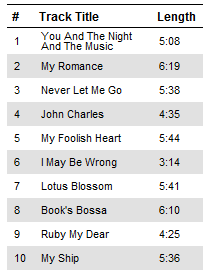
![]()

Wolfgang Amadeus Mozart (1756 – 1791) was a composer from the Classical Period (1750 – 1820). He was a prodigy and incredibly prolific for such a short life (35 years). He was composing music for piano and violin at the age of 5 and became court musician in Salzburg at the age of 17, then settled in Vienna. His last work, Requiem, was unfinished at the time of his death. When he wrote the piano concertos in this album, he was also working on the opera Don Giovanni.
Ah, Mozart. Nothing but beautiful melodies. Great articulation and detail, and an excellent soundstage. The benefits of 24/88.2 are evident in the piano when single keys are struck. Silky smooth.
Mozart Piano Concertos, Vol. 4 – Christian Zacharias, Orchestre de Chambre de Lausanne – MDG – 2008 – 24 Bit/88.2 kHz – Category: Classical
- Performance:

- Sonics:


![]()
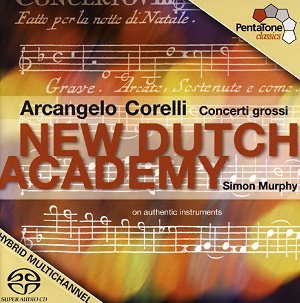
Arcangelo Corelli (1653 – 1713) is one of my favorite composers from the Baroque Period (1600 – 1750). Already a success at composition by the age of 19 in France, he moved to Germany, and then to Rome. His violin compositions set the stage for violin technique that followed him. Of his numerous works, 12 were Concerti Grossi.
I love Baroque music, and Corelli typifies the style and character as much or more than any other Baroque era composer. The music contains only strings, but Corelli uses them to deliver a sound that almost makes you think there is some brass in the background. Microphone placement is near perfect.
Arcangelo Corelli – Concerti Grossi – Simon Murphy, New Dutch Academy – PentaTone Classics – 2004 – 24 Bit/88.2 kHz – Category: Classical
- Performance:

- Sonics:

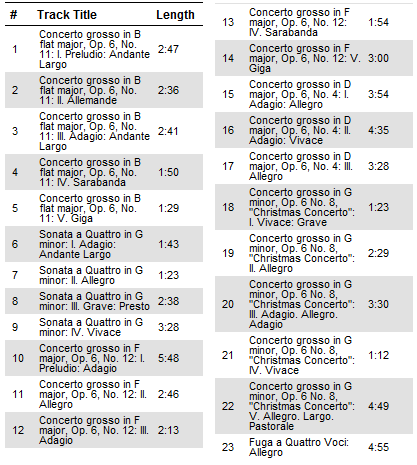
![]()
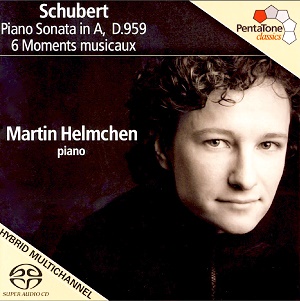
Franz Schubert (1797 – 1828) lived even a shorter life than Mozart, dying at the age of 31. The sonata in this album, Piano Sonata in A, was considered his most positive and optimistic, and is interpreted beautifully by Martin Helmchen. Schubert was not popular during his lifetime, but his music certainly influenced those who followed him, including Franz Liszt, Johannes Brahm, and Robert Schumann. Schubert was a member of the Romantic Period of composition (1815 – 1910). When he was in Vienna, Antonio Salieri (the composer – supposed villain – who tells the story of how he tried to squash Mozart’s career in the movie Amadeus) noticed Schumann not for his instrumental playing ability, but for his singing voice. His love for Countess Karoline Eszterházy was, unfortunately, unrequited.
This has the better of the two versions of the Piano Sonata in A, compared to the Zacharias version, reviewed below. The soloist plays with such dynamics!
Franz Schubert – Piano Sonata in A – Martin Helmchen – PentaTone Classics – 2008 – 24 Bit/88.2 kHz – Category: Classical
- Performance:

- Sonics:


![]()
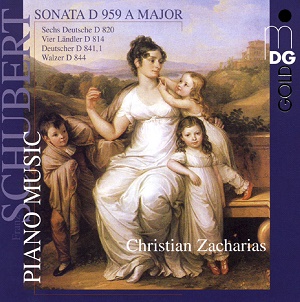
This album from Schubert’s works contains the same Sonata in A that is in the album above, but played by a different pianist, Christian Zacharias. The sonatas were composed near the end of his life. There are also four Dances. It is interesting to hear the same piece by two different pianists. Just as symphonies will be interpreted differently by various orchestras (mainly the director), so are compositions for individual instruments.
This array of Schubert’s music I would classify as Easy Listening. Good background for reading. The recording seems to have been made in a large hall.
Franz Schubert – Piano Music – Christian Zacharias – MDG Records – 2008 – 24 Bit/88.2 kHz – Category: Classical
- Performance:

- Sonics:

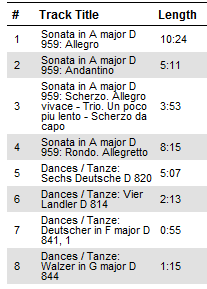
![]()


